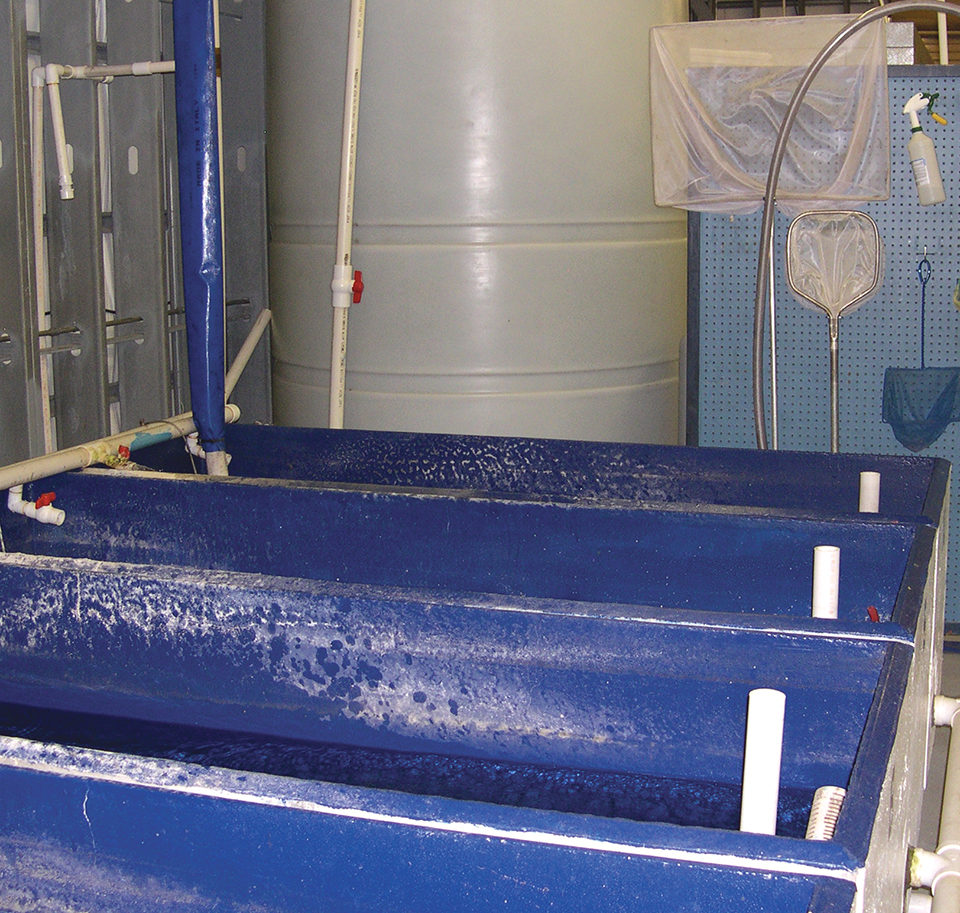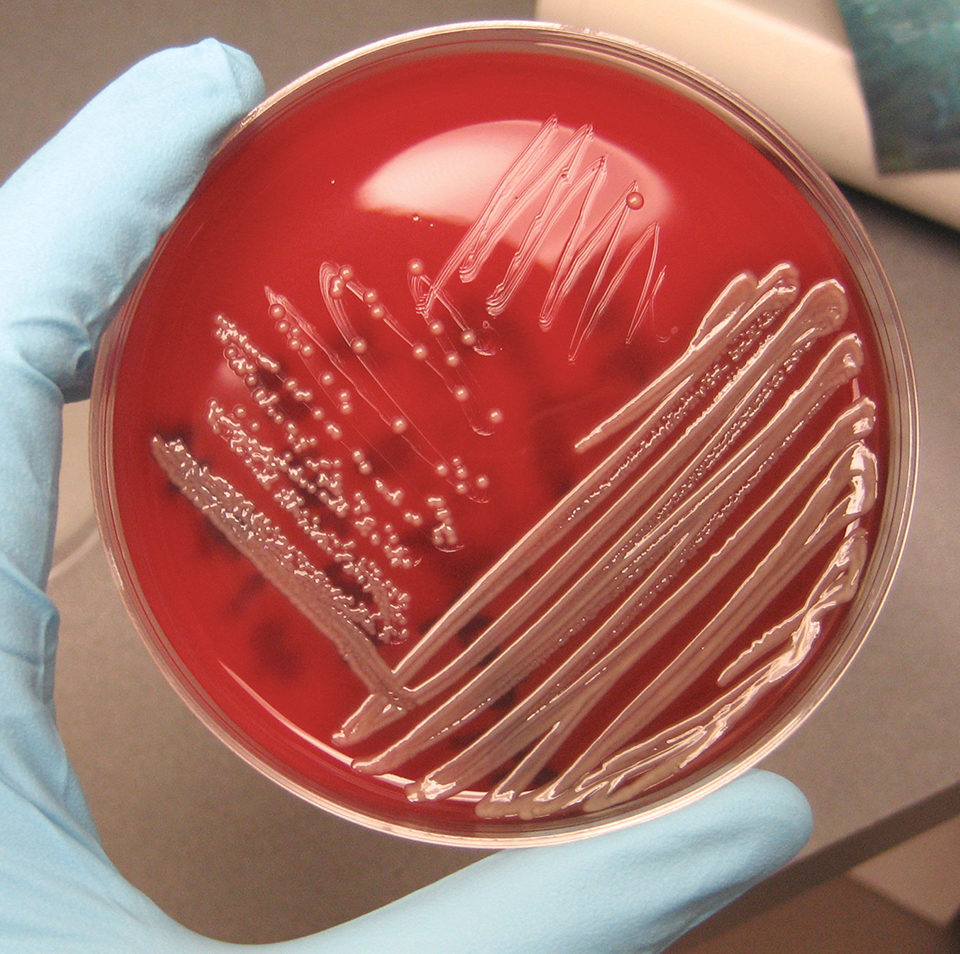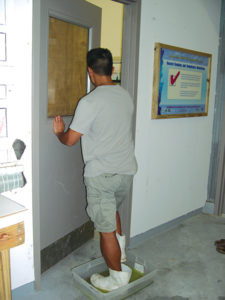Understand potential disease pathogens and implement good biosecurity measures

Concerns over water quality and usage, and effluents in aquaculture have increased interest and research in recirculating system design. However, improper management of recirculating systems can easily negate any benefits. In worst-case scenarios, poor management can result in problems that become entrenched within systems that then require depopulation and disinfection for resolution.
Overall optimal health and prevention of disease, not disease management, should be day-to-day goals. Early consultation with aquatic animal veterinarians or other health specialists, and/or laboratory testing prior to disease outbreaks are wise investments of time and money.

Major goals
Working with aquatic veterinarians or other specialists, health managers should focus on two major goals during the development of their health management programs: maximizing immunocompetence in fish populations and reducing or eliminating potential pathogens such as parasites, bacteria, viruses, and fungi in both fish and culture systems.
These goals are best achieved through the application of basic principles of preventative medicine. These principles, in turn, are based on knowledge of species- and age-specific biology including environmental, social, immunological, and nutritional preferences. An understanding of potential disease pathogens for the species under culture and good biosecurity are also needed.
Concurrent design, management
Systems and management schemes should be designed concurrently, with significant input from farm or hatchery managers on the species and intended purposes of the systems. Design should facilitate aquaculturists’ adherence to principles of preventative medicine through appropriate management techniques. For example, the sizes and numbers of tanks for the species and life stages to be held should be taken into consideration with allowances for future growth, increased production, and contingencies.

Too often aquaculturists are faced with inadequate space, forcing higher-than-expected densities. Water flow rates and currents should be comfortable for the species but adequate to remove ammonia and other toxins. Redundancy in case of system failure or disease problems has become an important concept with regard to both available pumps and filtration equipment, and multiple separate systems.
Filtration equipment should be sized appropriately for the estimated fish load, providing adequate mechanical, biological, and sterilization capacity. Routine protocols for all operations should be easily followed and understood. System complexities should not be beyond the capacity of those who are expected to manage them.
Biosecurity
Biosecurity is a very important concept generally understood as the deterrence of potential biological threats from pathogens. However, any factors that depress animals’ defense mechanisms or immune system functions, including poor water quality or improper handling, should also be considered threats to biosecurity.
Normally found in the environment or on animals in small numbers that do not cause clinical disease, many pathogens are opportunistic. Most of these are not a major concern. Good biosecurity against them relies heavily on environmental manipulation and good husbandry techniques that maximize immune system function.
On the other hand, even small numbers of certain pathogens can enter a facility and cause significant disease if environmental factors are only slightly suboptimal. For many cultured species, viruses are a major concern, although parasitic, fungal, and bacterial pathogens such as mycobacteria and Streptococcus species can also be issues.
The major components of good biosecurity programs include quarantine, sanitation, and disinfection. In addition, special attention to food sources, especially live or frozen foods, is critical because they can contain infectious pathogens. Biosecurity programs are intended to reduce or eliminate the flow of pathogens from new fish to resident fish, and vice versa.
Quarantine
New fish are often more stressed and more likely to shed pathogens. Quarantine allows these fish to acclimate to their new surroundings and regain health. Resident fish may be healthy, but carry pathogens for which they have developed immunity. An adequate quarantine period prevents these resident fish from infecting the new fish, which are often immunocompromised.
The main elements of quarantine include:
- All-in, all-out stocking in which different fish populations are moved as a group with no commingling. This is more practical for juvenile and growout stages.
- Isolation or separation where physical barriers between groups prevent potential contamination.
- Observation and diet adjustment. Animals in quarantine can be observed for abnormal behavior or appearance.
- Sampling for early examination of fish for specific pathogens.
- Treatments to reduce or eliminate infectious pathogens.
Sanitation
As a biosecurity component, sanitation reduces the overall pathogen load in a system. Dead or moribund fish should be removed as soon as possible to prevent cannibalism, fish-to-fish contact, or waterborne spread of pathogens. Uneaten food, detritus, and dissolved organics can act as food or reservoirs for pathogens, as well.
Disinfection
Keeping supplies off floors helps prevent the accidental introduction of pathogens into systems. Finally, a preventative mindset must be instilled in personnel and visitors so that relevant practices – disinfectant foot baths, net and siphon dips, and disinfection of hands and equipment that contacts fish or system water – become routine.
In the absence of specific system-dedicated equipment, disinfection of shared nets, siphon hoses, and other tools reduces the spread of disease-causing organisms. Ultraviolet sterilizers or ozone disinfection of system water can help reduce overall numbers of pathogens, as well.
Practical applications

Adherence to routine management protocols for day-to-day operations – preferably with written standard operating procedures and appropriate daily records that address system maintenance, employee training, and overall quality control – is key to successful health management. In addition, strict recordkeeping of all relevant information (including water quality parameters, feeding practices, growth rates and color parameters, spawning data, and other general observations) can help demonstrate trends and be very useful in problem solving and future prevention.
Separate systems and areas for the quarantine of incoming fish and different life stages should be mandatory. Diseases like mycobacteriosis can cause more problems in older broodstock and spread to offspring. Consequently, older broodstock should be rotated out of production and replaced with newer broodstock as soon as possible.
Sanitation and disinfection procedures based on tank design should regularly remove detritus from holding areas, filters, and sumps, and flush out pipes and mechanical and biological filtration systems. These procedures should be designed so that the overall program is not onerous.
Contingency management
System and management design should also allow for management of unforeseen contingencies, including disease outbreaks. Designs should permit fish populations in multitank systems to be taken off line and separated from other fish for isolation and treatment purposes. Tank covers should be available to reduce the aerosol spread of pathogens.
Working with fish health specialists, aquaculturists should become familiar with the diseases commonly seen in the species groups being raised. Barring that, the diseases seen in wild fish or related species should be understood. This practical knowledge should include such information as the life cycles in which parasites are susceptible to treatment, pathogen modes of transmission and susceptibility to disinfectants, and host and environmental factors that precipitate disease.
In addition, the effects of various treatment regimens on system components should be considered, as well as human safety and legal issues.
Science-based solutions
Finally, solid, science-based problem-solving approaches are critical for efficient resolution of disease outbreaks. These include reviews of all relevant records on the species group, management, and system; examination of the system components and current water quality parameters; observations of the animals; and diagnostics. Thorough work-ups should be performed with the assistance of a specialist.
Records should be examined at the end of each production cycle to determine success and permit goal setting for the next cycle. Standard operating procedures should be living documents that can be easily updated as new problems arise, or as new products or techniques increase efficiency.
(Editor’s Note: This article was originally published in the November/December 2006 print edition of the Global Aquaculture Advocate.)
Now that you've finished reading the article ...
… we hope you’ll consider supporting our mission to document the evolution of the global aquaculture industry and share our vast network of contributors’ expansive knowledge every week.
By becoming a Global Seafood Alliance member, you’re ensuring that all of the pre-competitive work we do through member benefits, resources and events can continue. Individual membership costs just $50 a year. GSA individual and corporate members receive complimentary access to a series of GOAL virtual events beginning in April. Join now.
Not a GSA member? Join us.
Author
-
Roy P.E. Yanong, VMD
Tropical Aquaculture Laboratory
Department of Fisheries and Aquatic Sciences
University of Florida IFAS
1408 24th Street Southeast
Ruskin, Florida 33570 USA
Tagged With
Related Posts

Health & Welfare
10 paths to low productivity and profitability with tilapia in sub-Saharan Africa
Tilapia culture in sub-Saharan Africa suffers from low productivity and profitability. A comprehensive management approach is needed to address the root causes.

Health & Welfare
A holistic management approach to EMS
Early Mortality Syndrome has devastated farmed shrimp in Asia and Latin America. With better understanding of the pathogen and the development and improvement of novel strategies, shrimp farmers are now able to better manage the disease.

Responsibility
A review of water quality improvement products
Prof. Boyd examines products used by aquafarmers to improve water quality and conditions in their ponds and discusses their efficacy.

Responsibility
A look at unit processes in RAS systems
The ability to maintain adequate oxygen levels can be a limiting factor in carrying capacities for RAS. The amount of oxygen required is largely dictated by the feed rate and length of time waste solids remain within the systems.


